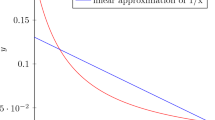Abstract
We investigate the possibility of using index forms as basic ingredients of cryptographically important functions. We suggest the use of a hash function based on index forms and we prove some important properties of the suggested function.
Similar content being viewed by others
References
A. Bérczes and J. Ködmön, Methods for the calculation of values of a norm form, Publ. Math. Debrecen, 63 (2003), 751–768.
A. Bérczes, J. Ködmön and A. Pethő, A one-way function based on norm form equations, Period. Math. Hungar., 49 (2004), 1–13.
Y. Bilu, I. Gaál and K. Győry, Index form equations in sextic fields: a hard computation, Acta Arith., 115 (2004), 85–96.
H. Cohen, A course in computational algebraic number theory, Graduate Texts in Mathematics 138, Springer-Verlag, Berlin, 1993.
H. Feistel, W. A. Notz and J. L. Smith, Some cryptographic techniques for machine-to-machine data communications, Proceedings of the IEEE, vol. 63, 1975, 1545–1554.
I. Gaál, Diophantine equations and power integral bases. New computational methods, Birkhäuser Boston Inc., Boston, MA, 2002.
I. Gaál and K. Győry, Index form equations in quintic fields, Acta Arith., 89 (1999), 379–396.
I. Gaál, A. Pethő and M. Pohst, Simultaneous representation of integers by a pair of ternary quadratic forms—with an application to index form equations in quartic number fields, J. Number Theory, 57 (1996), 90–104.
I. Gaál and N. Schulte, Computing all power integral bases of cubic fields, Math. Comp., 53 (1989), 689–696.
S. Goldwasser and M. Bellare, Lecture Notes on Cryptography, MIT Press, Boston, 2001.
S. Goldwasser and S. Micali, Probabilistic encryption, J. Comput. System Sci., 28 (1984), 270–299.
J. B. Kam and G. I. Davida, Structured design of substitution-permutation encryption networks, IEEE Trans. Comput., 28 (1979), 747–753.
S. Lang and A. Weil, Number of points of varieties in finite fields, Amer. J. Math., 76 (1954), 819–827.
A. J. Menezes, P. C. Van Oorschot and S. A. Vanstone, Handbook of applied cryptography, CRC Press Series on Discrete Mathematics and its Applications, CRC Press, Boca Raton, FL, 1997.
M. Pohst, Invarianten des total reellen KÖrpers siebten Grades mit Minimaldiskriminante, Acta Arith., 30 (1976), 199–207.
B. Schneier, Applied cryptography. Protocols, algorithms and source code in C, 2nd ed., John Wiley & Sons, 1996.
A. Webster and S. Tavares, On the design of S-boxes, Advances in Cryptology— CRYPTO′85, LNCS 218, 1986, 523–534.
Author information
Authors and Affiliations
Corresponding author
Additional information
Communicated by Attila Pethő
The research was supported in part by the Hungarian Academy of Sciences, by grants T048791 and K67580 of the Hungarian NFSR, by the National Office for Research and Technology and by the grant JP-26/2006.
Rights and permissions
About this article
Cite this article
Bérczes, A., Járási, I. An application of index forms in cryptography. Period Math Hung 58, 35–45 (2009). https://doi.org/10.1007/s10998-009-9035-8
Received:
Accepted:
Published:
Issue Date:
DOI: https://doi.org/10.1007/s10998-009-9035-8




